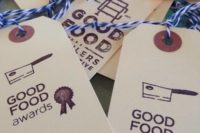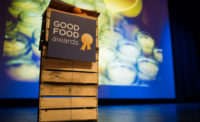Dark milk chocolate (up to 68 percent cocoa content bars), bold sweeteners (sorghum, maple and honey caramels), uncommon spices (fennel — both pollen and seed — and black sesame), and Walla Walla sweet onion are among the standout winning chocolates and confections honored Jan. 21 at the Good Food Awards.
Among the winners were 11 American craft chocolate makers and 18 confectioners, who received their awards before a crowd of about 900 people assembled in the Herbst Theater, a historic landmark that hosted the signing of the United Nations charter in 1945.
Now celebrating its seventh year, the Good Food Awards are the bellwether for the direction of the American craft food movement; a movement that celebrates not only great taste, but authenticity and sustainable production. Moreover, this movement is growing. Submissions are up 20 percent, estimates chocolate category co-chair Sunita de Tourreil.
“The awards have a social mission of taking a broad ecosystem approach to supporting a healthy American food industry; by rewarding carefully made, responsibly made food,” de Tourreil explains.
And for the winners, “these awards provide an opportunity for increased media exposure and visibility. They offer an entree to wholesale buyers and an opportunity in increase their distribution and sales,” says confectionery category co-chair Jesse Manis.
Other trends gleaned from among the chocolate winners, notes de Tourreil, include the debut of single origin beans from Haiti and Tanzania, as well as from new areas in existing origins producers like Ecuador. She attributes this trend to several causes, the first being the use of fermentation experts to guide this critical phase of chocolate production. Another trend is the growing popularity in broker/ aggregators specializing in sourcing these exquisite beans and selling them to suppliers who, in turn, make them available in quantities small enough to fit the budgets of craft chocolate makers.
De Tourreil has been a chocolate category chair for two years. She is the owner of The Chocolate Garage in Palo Alto, Calif., a curated specialty chocolate boutique.
Among the confectionery category winners, Manis notes, “an increased level of sophistication, more refined, better skills demonstrated, increased attention to detail, and creative use of flavor.” He particularly calls out the flavors of maple and honey; fruit, floral, and herbal; savory/sweet infusions; insects; and vegan – using coconut as a dairy substitute.
A Good Food Awards confectionery category chair for two years, Manis is co-founder of Cacao, which also features a curated collection of chocolate bars and house-made selection of chocolate drinks. He discovered his passion for chocolate when working at Fran’s Chocolates in Seattle.
As the organizers explain, the Good Food Awards represents, “not just the best of America’s growing food movement, but the best of America. At a time when the values [of what] our country stands for are in question, they exemplify all that is right from coast to coast: our proud immigrant history, stewardship of a rich and fertile agricultural landscape, a spirit of innovation and the daily choice to balance personal gain with the wellbeing of the commons.”
Opening remarks were given by American Indian activist and environmentalist Winona LaDuke. The Good Food Award medals were bestowed by the culinary luminary Alice Waters (owner of the iconic Berkeley restaurant Chez Panisse and often described as the mother of new American cuisine) and Nell Newman (organic pioneer and founder of Newman’s Own Organics).
In addition to chocolate and confectionery, 12 other food categories were honored: beer, charcuterie, cheese, cider, coffee, fish (new category), honey, oils, pantry, pickles, preserves and spirits.
CHOCOLATE WINNERS
Areté Fine Chocolate, Gianduia Bar, California
Castronovo Chocolate, Dominican Republic Dark Milk 50%, Florida
Charm School Chocolate, 70% Dark Belize, Maryland
Creo Chocolate, Minty Dark 73%, Oregon
Cultura Craft Chocolate, 70% Haiti, Colorado
Fresh Coast Chocolate Co., Belize 70% & Tanzania 70%, Michigan
Fruition Chocolate, Marañón Canyon Dark Milk 68% & Hudson Valley Bourbon Dark Milk 61%, New York
LetterPress Chocolate, Costa Esmeraldas, Ecuador 70%, California
Lonohana Estate Chocolate, Milk and Ginger & Lonohana Estate 73%, Hawaii
Parliament Chocolate, Tanzania: Kilombero Valley, California
Patric Chocolate, Sweet and Sassy & Piura Dark Milk & 58% Dark Milk Chocolate, Missouri
CONFECTION WINNERS
Alma Chocolate, Chocolate Pistachio Toffee, Oregon
Askinosie Chocolate, Dark Milk Chocolate + Black Licorice CollaBARation™ Bar, Missouri
Batch PDX, Candy Cap Mushroom Truffle & Ghost Pepper Truffle, Oregon
Big Picture Farm, Farmstead Chocolate Covered Caramels & Farmstead Caramels, Vermont
Fat Toad Farm, Vanilla Bean Goat’s Milk Caramel Sauce & Spicy Dark Chocolate Goat’s Milk Caramel Sauce, Vermont
Fran’s Chocolates, Almond Gold Bar, Washington
French Broad Chocolates, Sorghum Caramel, North Carolina
GerDan Chocolates, Gingerbread Caramels, North Carolina
Hawaiian Nougat Company, Lilikoi Nougat, Hawaii
Kakao Chocolate, Chai Tea Truffle & Norton Pâtés du Vin, Missouri
Little Apple Treats, Apple Pie Spice Caramels, California
Mayana Chocolate, The Space Bar & Coconut Dream Bar, Wisconsin
Seersucker Candy Co., Muzzle Loaders, Tennessee
The Chocolate Maker’s Studio, Fennel Pollen Caramel Bar, Oregon
Theo Chocolate, Walla Walla Sweet Onion Caramel, Washington
Valenza Chocolatier, Barolo Bonbon, California
Vermont Amber Organic Toffee, Fennel Seed Toffee, Vermont
Zak’s Chocolate, Cacao Nib Caramel, Arizona
Curtis Vreeland, president of Vreeland & Associates, specializes in confectionery market research. He has been spotting trends in the premium confectionery sector for Candy Industry Magazine for years and years.





